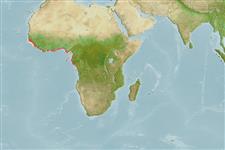Environment: milieu / climate zone / kisaran kedalaman / distribution range
Ekologi
laut; air tawar; payau pelagic-neritic; kisaran kedalaman 0 - 35 m (Ref. 86940). Tropical; 17°N - 7°S, 17°W - 14°E (Ref. 54448)
Africa: Atlantic coasts from northern parts of Senegal south to Baie de Saint-Bras in Angola (Ref. 188, 3509), also in lagoons and river estuaries (Ref. 188, 81270).
Length at first maturity / Size / Weight / umur
Kematangan: Lm 13.0, range 13 - 18 cm
Max length : 30.0 cm SL jantan/; (Ref. 27000); common length : 16.0 cm SL jantan/; (Ref. 188); Berat maksimum terpublikasi: 144.00 g (Ref. 86940)
deskripsi pendek
Kunci identifiaksi (pengenalan) | Morfologi | Morfometrik
Duri punggung (Keseluruhan (total)) : 0; duri punggung lunak (Keseluruhan (total)) : 14 - 17; Duri dubur: 0; Sirip dubur lunak: 45 - 50; vertebrata, bertulang belakang: 42 - 43. Diagnosis: Body moderately deep, compressed, belly with a sharp and serrated keel of scutes from gill opening to anus, 25-27 pre-pelvic and 6-8 post-pelvic sharp scutes (Ref. 187, 188, 81270). Eye large, mouth pointing upwards, lower jaw projecting (Ref. 187, 188). Dorsal fin at or before midpoint of body; anal fin long, with more than 40 finrays, its origin below dorsal fin base; pelvic fins small (Ref. 187, 188). Swimbladder with two short tubes passing back in the muscles on either side of haemal spines (Ref. 188). Other clupeoid fishes in the area are more slender, have a much shorter anal fin and the lower jaw is not strongly projecting (Ref. 188).
Body shape (shape guide): fusiform / normal; Cross section: compressed.
Found in the marine environment, pelagic, along beaches and just off shore, down to about 25 m, also in lagoons and estuaries, penetrating into almost freshwater (Ref. 187, 188, 54448). A marine migrant (Ref. 117399). Rarely found below 35 m depth (Ref. 86940). It feeds on small planktonic animals, e.g. small fish and crustaceans; it doesn't seem to feed on plankton (Ref. 188, 3166, 47405).
Whitehead, P.J.P., 1985. FAO Species Catalogue. Vol. 7. Clupeoid fishes of the world (suborder Clupeoidei). An annotated and illustrated catalogue of the herrings, sardines, pilchards, sprats, shads, anchovies and wolf-herrings. FAO Fish. Synop. 125(7/1):1-303. Rome: FAO. (Ref. 188)
Status IUCN Red List (Ref. 130435: Version 2025-1)
ancaman kepada manusia
Harmless
penggunaan manusia
Perikanan: komersial
Alat, peralatan
laporan khas
muat turun XML
Sumber internet
Estimates based on models
Preferred temperature (Acuan
123201): 25.9 - 28, mean 27.5 °C (based on 160 cells).
Phylogenetic diversity index (Acuan
82804): PD
50 = 0.5000 [Uniqueness, from 0.5 = low to 2.0 = high].
Bayesian length-weight: a=0.00676 (0.00557 - 0.00821), b=3.02 (2.97 - 3.07), in cm total length, based on LWR estimates for this species (Ref.
93245).
Trophic level (Acuan
69278): 3.6 ±0.2 se; based on diet studies.
Daya lenting (Acuan
120179): Tinggi, Waktu penggandaan populasi minimum kurang dari 15 bulan (K=0.8-1.3).
Prior r = 1.19, 95% CL = 0.79 - 1.79, Based on 3 data-limited stock assessments.
Fishing Vulnerability (Ref.
59153): Low vulnerability (21 of 100).
🛈
Climate Vulnerability (Ref.
125649): High to very high vulnerability (73 of 100).
🛈
Nutrients (Ref.
124155): Calcium = 206 [110, 411] mg/100g; Iron = 2.01 [1.19, 3.28] mg/100g; Protein = 19.4 [18.0, 20.7] %; Omega3 = 0.397 [0.206, 0.739] g/100g; Selenium = 44.4 [20.6, 85.5] μg/100g; VitaminA = 20.2 [8.0, 49.5] μg/100g; Zinc = 1.52 [1.07, 2.15] mg/100g (wet weight);
